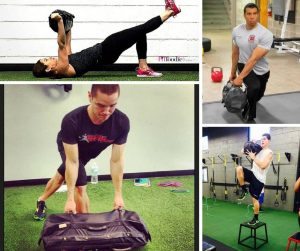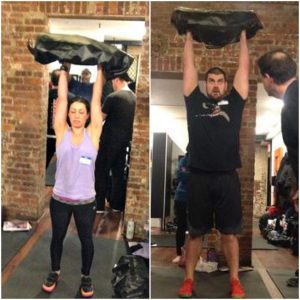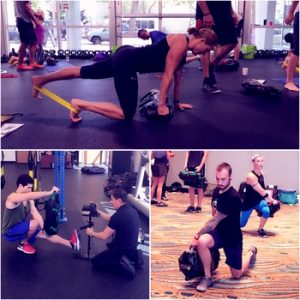Is There Such A Thing As A “Good” Sandbag?
2017-01-23
It is something that I get reminded of maybe once a month. Often, I forget to write about it, but sometimes it is so in my face that I can’t help but write a blog post about it.
What is it?
Answering the question “what makes a sandbag good?!”
Where does such a question even begin? Part of it is hearing how people debate which is better, a cast iron or competition kettlebell! How about Olympic lifters debating which barbell is the best to Clean and Snatch? Hey, how about which is a better suspension trainer?
Pretty much for any piece of fitness equipment there are standards, guidelines, and qualities that make them the best or not. Yet, as you could guess, when it comes to “sandbags” there is very little consideration that goes into them. Kinda odd considering it is the most “non-cooperative” of fitness tools.
I do understand, the history of the sandbag is one of being, well a duffel bag with garbage bags in it (that was what one looked like on a good day ten years or so ago!). That doesn’t lend itself to having much a discussion about what makes a sandbag “good” and are they all the same?
Fast forward there are A LOT of sandbags that do LOOK like the Ultimate Sandbag, but there are significant differences. I always said that it is our responsibility to educate the public, so this post is to help you understand how different a sandbag can REALLY be!
Step 1: Have a system
I could easily say this about anything good in functional fitness, but sandbags easily fall into this discussion. Why? Most of what I see people do that aren’t using DVRT are basically running, throwing, and slamming sandbags. That wouldn’t be inherently a bad thing, but honestly I don’t know what they are trying to accomplish, I don’t know what unique stimulus that the sandbag is providing?
DVRT Master Elizabeth Andrews demonstrates some of the subtle concepts of DVRT that make a HUGE difference!
When people ask us what makes the Ultimate Sandbag different, the FIRST thing I say is that it is made for our Dynamic Variable Resistance Training (DVRT) system. That is important because when you have things you want to accomplish and specific intent with a tool you can design it to meet those goals.

A system also guides you on what is good and bad in any form of training. There are good and bad ways to use ANY fitness tool. While that may seem odd for a “soft” tool like a sandbag, the reality is because of the unpredictable movement of it you need to be even MORE aware of good versus bad technique.
This is THE topic I am MOST adamant about. Why? This of all things has the LEAST to do with the Ultimate Sandbag itself and more with safety, results, and purpose. There is A LOT of unsafe and bad training of sandbags out there that puts people at risk of injury and if nothing else finding very little purpose in such a wonderful tool!
Make sure you are following someone with education, that understands good movement, and ask LOTS of questions!
Step 2: You are deliberate about the handles
One of the biggest changes we made to the “world” of sandbags was to put handles on our Ultimate Sandbags. MAN, that was controversial because people thought we were taking away one of the main benefits of sandbags, grip strength.
However, what people didn’t realize was in putting handles on the Ultimate Sandbag we changed the leverage, making grip even stronger AND expanding the possibilities with this unique form of training.
It wasn’t like we just smacked handles on our Ultimate Sandbags either. We tested a lot of lengths and distances to fit the frame and movement of MOST people. Even though it is impossible to fit everyone, years of testing has made it where we are pretty much on spot to what seems like everyone! From those that are small in stature to some pretty large individuals.
These details are important because if the handles are not placed appropriately on the sandbag you lose the ability to integrate more muscles, use the core to stabilize your back, and pose a risk to your shoulders.
If you don’t have the RIGHT length to them either you change the dynamics of many exercises, often for the worse!

It doesn’t seem to matter if you are 5’6 or 6’6 the Ultimate Sandbag fits so many different fitness levels and body types!
Step 3: You kill canvas!
Yes, this was ANOTHER very controversial move on our part. After all, canvas duffel bags have been THE sandbag for many. Yet, if you ask people why that is, it is often a matter of convenience than any serious design.
When you sit down and think about, “if I could make a sandbag out of anything” any type of canvas is a REALLY lousy choice! Why?
- Canvas will slightly expand over time allowing for more leakage over the lifespan of the sandbag.
- Canvas absorbs sweat and moisture. Yes, I know some say they are resistant, this is just NOT the case! Over the use of the sandbag the material breaks down making it absorb more, well, nastiness if you will. Plus, you can’t do what we JUST did by accident! It has been rainy here and I forgot about two Ultimate Sandbags I keep outside for workouts. Well, they got POURED on for two days, how do they look? Pretty much like it never happened! I don’t recommend you do this on purpose, but it DOES show the resiliency of our Ultimate Sandbags!

3. Canvas KILLS your skin! Whether it is cleaning to fists, or grabbing right onto the sandbag having a surface that doesn’t make your hands literally bleed is REALLY important. Getting rid of the idea of canvas makes using your sandbag so much better and more versatile.
4. Canvas isn’t the strongest material! Like I said, most people don’t have a reason for using canvas for sandbags other than they were trying to make something else into a sandbag. When you think about designing something specific for fitness and human performance, you want something that can be the best, the strongest, and have the best feel. Canvas doesn’t do any of these things!
I could keep going, but I think this is a great way to start educating more people on why DVRT Ultimate Sandbag Training is the standard for not just sandbags, but functional fitness. The details, the subtleties, and the nuances make ALL the difference in the world.
I remember my Dad telling me that first to market doesn’t mean much, being the BEST does! We are proud that DVRT Ultimate Sandbag Training can be both!!!
Don’t take our word for it, save 20% and take our 30 day money back guarantee with coupon code “save20” HERE

© 2025 Ultimate Sandbag Training. Site by Jennifer Web Design.






